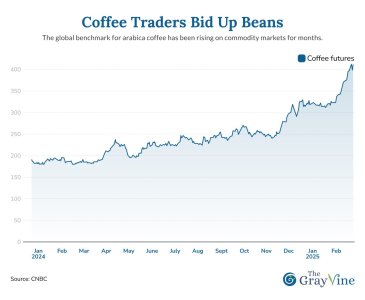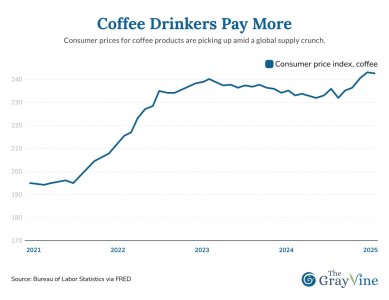Brewing trouble: Is a global coffee price surge coming for your cup?
- Replies 4
For many of us, the day doesn't truly begin until we've savored that first sip of coffee. It's a ritual that awakens the senses and sets the tone for the day ahead.
But brace yourselves, coffee aficionados—your cherished morning brew is on the brink of becoming a luxury item.
Here at The GrayVine, we understand that a good cup of joe is more than just a beverage–it's a comforting companion. That's why we're diving deep into the bitter truth behind the rising cost of coffee and what it means for your wallet.
The world of coffee is facing a storm of climate change, economic pressures, and agricultural turmoil.
The price of arabica coffee, the bean behind your favorite lattes and cappuccinos, has more than doubled in the past year, with 25% of the surge beginning since the start of 2025.
A pound of these precious beans now costs over $4 on the commodity markets, a price point that's sending ripples through the entire coffee industry.
“Expect retail coffee prices to keep grinding higher,” Bank of America analysts recently stated, even with “consumers showing signs of price fatigue.”

Why is this happening? Let's unpack the factors:
1. Climate change
Our planet's changing climate is wreaking havoc on coffee crops worldwide. From the lush fields of South and Central America to the fertile lands of Southeast Asia and East Africa, coffee farmers are battling unpredictable weather patterns.
Brazil, a coffee powerhouse, is grappling with its worst drought in seven decades, leading to water shortages and failed crops. Vietnam, another coffee giant, has faced a brutal combination of drought and flooding, thanks to climate change-amplified typhoons like Typhoon Yagi. These two countries compose 56% of the world’s supply.
Even chocolate prices are up this year because of the higher temperatures and rainfall levels ruining cacao yield in West Africa.
2. Rising temperatures and pests
As temperatures climb, coffee plants, especially the delicate arabica species, are under threat. These conditions are not only reducing yields but also increasing the prevalence of diseases and pests that can decimate entire plantations.
“As the long-term climate changes, these weather conditions are far more likely to hit extremes and cause losses in coffee yields as well as volatility to coffee production,” stated Jeffrey Sachs, a sustainable economist at Columbia University.
Climate is said to affect the increase of diseases in coffee crops, which leads to lesser yields for farmers. Studies have shown that the arabica bean is especially vulnerable to climate change.
3. Domestic production
While the US does produce some coffee in regions like Puerto Rico, Hawaii, and California, it's a mere drop in the bucket compared to our national consumption. We rely heavily on imported beans, and when global supplies take a hit, so do our choices and prices.
The overall cost of drip coffee has increased every year since 2021, when it used to be $0.12 per cup, as per NIQ. Now, one cup of drip coffee costs $0.18, while coffee pods have also risen from $0.50 per cup in 2021 to $0.55 at the start of 2025.
Bank of America analysts have sounded the alarm, predicting a “pronounced” increase in retail coffee prices.
Major food companies, which have so far absorbed some of the shock, are expected to pass on these costs to consumers.
Instant coffee prices have jumped significantly, and even the cost of a humble cup of drip coffee has been on a steady climb. Those convenient coffee pods? They're not immune either, with prices ticking upward year after year.
Also read: Cardiologists reveal the one type of coffee that's damaging your heart health every day!
As coffee lovers and savvy consumers, it's essential to understand the forces at play and how they might affect our daily lives. Here are a few tips to navigate the rising tide of coffee costs:
1. Explore home brewing: Investing in a good coffee maker and buying beans in bulk can help you save in the long run. You can check out this coffee trick here–baristas hate to see this coming.
2. Support sustainable brands: Choose coffee companies that invest in sustainable practices and support their farmers.
3. Be mindful of consumption: Savor your coffee, and consider reducing waste by avoiding single-use cups and pods.
Source: NBC News / Youtube.
The spike in coffee prices is just one symptom of a much larger issue. Climate change is poised to disrupt global food supplies in ways we're only beginning to understand.
Experts like Jeffrey Sachs urge rapid action to reduce greenhouse gas emissions and invest in agricultural resilience.
The global coffee shortage has led the US imported coffee bean supplies to its lowest level since November, as reported by the Intercontinental Exchange. Arabica coffee production in Brazil is set to decline by 12.4% from last year, according to the Brazilian ministry of agriculture–this is said to be the lowest level since 2022.
Also read: What’s causing the coffee costs to skyrocket–Do you have to cut back on your daily cup?

Have you noticed a change in your coffee expenses? Are you trying new ways to enjoy your brew on a budget? Share your experiences and tips with the community in the comments below!
But brace yourselves, coffee aficionados—your cherished morning brew is on the brink of becoming a luxury item.
Here at The GrayVine, we understand that a good cup of joe is more than just a beverage–it's a comforting companion. That's why we're diving deep into the bitter truth behind the rising cost of coffee and what it means for your wallet.
The world of coffee is facing a storm of climate change, economic pressures, and agricultural turmoil.
The price of arabica coffee, the bean behind your favorite lattes and cappuccinos, has more than doubled in the past year, with 25% of the surge beginning since the start of 2025.
A pound of these precious beans now costs over $4 on the commodity markets, a price point that's sending ripples through the entire coffee industry.
“Expect retail coffee prices to keep grinding higher,” Bank of America analysts recently stated, even with “consumers showing signs of price fatigue.”

The global price of arabica coffee has more than doubled in the past year, with a significant surge in cost since the start of 2025. Image source: Nathan Dumlao / Unsplash.
Why is this happening? Let's unpack the factors:
1. Climate change
Our planet's changing climate is wreaking havoc on coffee crops worldwide. From the lush fields of South and Central America to the fertile lands of Southeast Asia and East Africa, coffee farmers are battling unpredictable weather patterns.
Brazil, a coffee powerhouse, is grappling with its worst drought in seven decades, leading to water shortages and failed crops. Vietnam, another coffee giant, has faced a brutal combination of drought and flooding, thanks to climate change-amplified typhoons like Typhoon Yagi. These two countries compose 56% of the world’s supply.
Even chocolate prices are up this year because of the higher temperatures and rainfall levels ruining cacao yield in West Africa.
2. Rising temperatures and pests
As temperatures climb, coffee plants, especially the delicate arabica species, are under threat. These conditions are not only reducing yields but also increasing the prevalence of diseases and pests that can decimate entire plantations.
“As the long-term climate changes, these weather conditions are far more likely to hit extremes and cause losses in coffee yields as well as volatility to coffee production,” stated Jeffrey Sachs, a sustainable economist at Columbia University.
Climate is said to affect the increase of diseases in coffee crops, which leads to lesser yields for farmers. Studies have shown that the arabica bean is especially vulnerable to climate change.
3. Domestic production
While the US does produce some coffee in regions like Puerto Rico, Hawaii, and California, it's a mere drop in the bucket compared to our national consumption. We rely heavily on imported beans, and when global supplies take a hit, so do our choices and prices.
The overall cost of drip coffee has increased every year since 2021, when it used to be $0.12 per cup, as per NIQ. Now, one cup of drip coffee costs $0.18, while coffee pods have also risen from $0.50 per cup in 2021 to $0.55 at the start of 2025.
Bank of America analysts have sounded the alarm, predicting a “pronounced” increase in retail coffee prices.
Major food companies, which have so far absorbed some of the shock, are expected to pass on these costs to consumers.
Instant coffee prices have jumped significantly, and even the cost of a humble cup of drip coffee has been on a steady climb. Those convenient coffee pods? They're not immune either, with prices ticking upward year after year.
Also read: Cardiologists reveal the one type of coffee that's damaging your heart health every day!
As coffee lovers and savvy consumers, it's essential to understand the forces at play and how they might affect our daily lives. Here are a few tips to navigate the rising tide of coffee costs:
1. Explore home brewing: Investing in a good coffee maker and buying beans in bulk can help you save in the long run. You can check out this coffee trick here–baristas hate to see this coming.
2. Support sustainable brands: Choose coffee companies that invest in sustainable practices and support their farmers.
3. Be mindful of consumption: Savor your coffee, and consider reducing waste by avoiding single-use cups and pods.
Source: NBC News / Youtube.
The spike in coffee prices is just one symptom of a much larger issue. Climate change is poised to disrupt global food supplies in ways we're only beginning to understand.
Experts like Jeffrey Sachs urge rapid action to reduce greenhouse gas emissions and invest in agricultural resilience.
The global coffee shortage has led the US imported coffee bean supplies to its lowest level since November, as reported by the Intercontinental Exchange. Arabica coffee production in Brazil is set to decline by 12.4% from last year, according to the Brazilian ministry of agriculture–this is said to be the lowest level since 2022.
Also read: What’s causing the coffee costs to skyrocket–Do you have to cut back on your daily cup?
Key Takeaways
- The global price of arabica coffee has more than doubled in the past year, with a significant surge in cost since the start of 2025.
- Climate change is having a major impact on coffee production, disrupting agriculture with extreme weather conditions like drought and floods.
- Consumers are expected to face higher retail coffee prices as cost increases from coffee producers are passed on by major food companies.
- Climate change is set to continue affecting global food supplies and coffee prices, underscoring the need for emissions reductions and investments in agricultural resiliency.
Have you noticed a change in your coffee expenses? Are you trying new ways to enjoy your brew on a budget? Share your experiences and tips with the community in the comments below!








